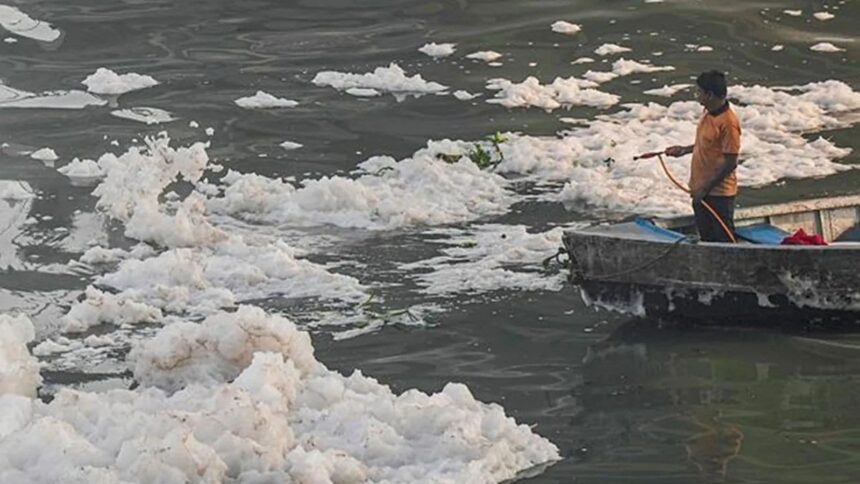From enhancing the environmental flow (E-flow) of the Yamuna to managing drains and removing encroachments from floodplains through a dedicated Special Task Force, the government has finalised a 30-point action plan to rejuvenate the river. The plan involves coordinated efforts from six agencies under the Centre and the Delhi government.
It is learnt that the action plan was drawn up following a high-level meeting chaired by Prime Minister on April 16 to review the Yamuna clean-up efforts, and address ’s drinking water concerns. Attendees included Union Home Minister , Union Jal Shakti Minister C R Patil, Delhi Chief Minister , and senior PMO officials such as P K Mishra, Principal Secretary to the Prime Minister, and Shaktikanta Das, Principal Secretary-2. A detailed presentation on the Yamuna’s cleaning and Delhi’s water supply was shared during the meeting.
Post the meeting, the 30-point roadmap was circulated among six key agencies: the Delhi Development Authority (DDA), National Mission for Clean Ganga (NMCG), Central Pollution Control Board (CPCB), Delhi Government, Delhi Jal Board, and the Municipal Corporation of Delhi (MCD). Each agency has been assigned specific responsibilities, with timelines ranging from June 2025 to March 2029.
Two major action points focus on increasing the E-flow of the Yamuna within Delhi and further downstream. The plan proposes discharging 773 million litres per day (8.95 cubic metre per second or cumecs) of treated water from the Coronation Pillar and Yamuna Vihar sewage treatment plants (STPs) into the river downstream of Wazirabad by September 2026. A dedicated conveyance system will be developed for this purpose. Additionally, an extra 6.23 cumecs of treated water from the Okhla STP (capacity: 563 MLD) will be released downstream of the Okhla barrage via the Yamuna canal, partially improving the river’s flow.
The Special Task Force is also tasked with removing floodplain encroachments within a year, targeting a completion date of September 2026.
Further, the plan includes creating around 500 MLD of additional sewage treatment capacity by March 2029, and connecting 1,799 unauthorised colonies to the sewage network. New STPs are proposed at Delhi Gate, Shastri Park, and Kailash Nagar. Several major drains—including Barapullah, Maharani Bagh, Mori Gate, Sonia Vihar, Delhi Gate, Kailash Nagar, and Shastri Park—will also be tapped and treated before discharge.
Describing the Yamuna as a “polluted drain filled with filth and garbage,” the had pledged to clean the river in its manifesto for the 2025 Delhi Assembly elections. Criticising the ’s governance — referred to as “AAP-DA” — the BJP claimed that despite spending Rs 8,500 crore, the AAP had failed to clean the Yamuna.
Promising to collaborate with the Centre, the BJP had also announced plans to develop the Yamuna Riverfront on the lines of ’s Sabarmati Riverfront. The proposal includes establishing 24×7 commercial spaces, theatres, interactive shows, and other entertainment venues along the banks.
As part of its broader vision, the BJP had also promised to set up a dedicated “Yamuna Kosh” (Yamuna Fund) to revitalise the river. The fund would support initiatives such as ensuring complete treatment of wastewater from key drains like Barapullah, Shahdara, and Ghazipur before it enters the Yamuna.
Main points of the 30-point action plan for cleaning the Yamuna
1. E-flow in the Yamuna
2. Drain management
3. Solid waste management
4. Sewage management
5. Governance and enforcement
6. Gap identification/monitoring and surveillance system
7. Flood plain protection/river-front development activities
8. Public outreach
9. Septage and dairy waste management
Agencies involved: Delhi Development Authority (DDA), National Mission for Clean Ganga (NMCG), Central Pollution Control Board (CPCB), Delhi Government, Delhi Jal Board, and Municipal Corporation of Delhi (MCD).
Timelines: from June 2025 to March 2029, depending on the action point.








